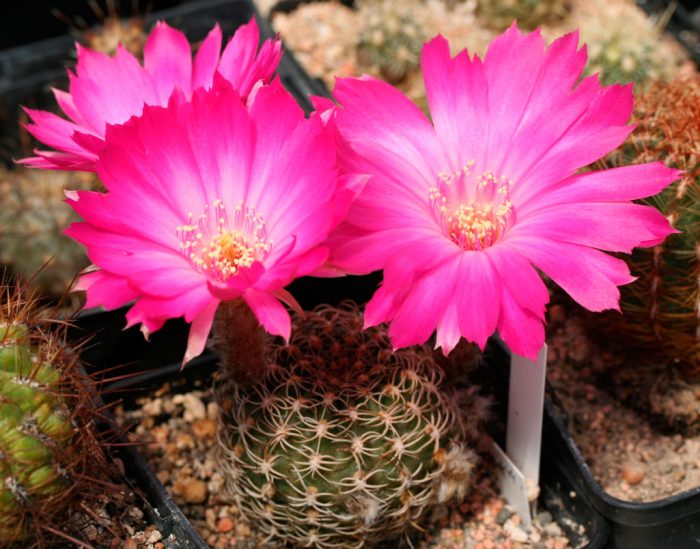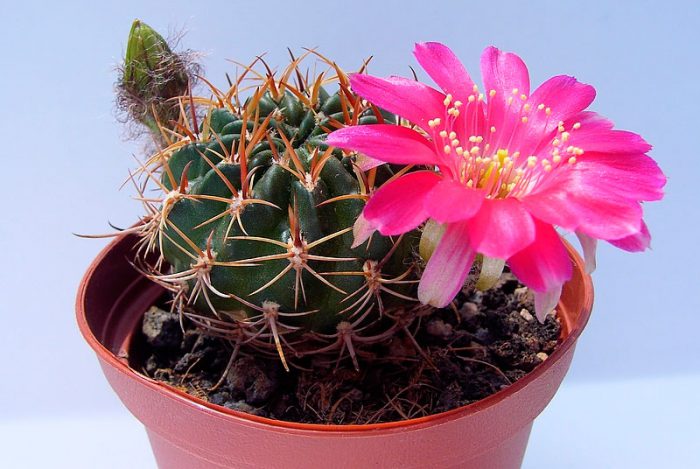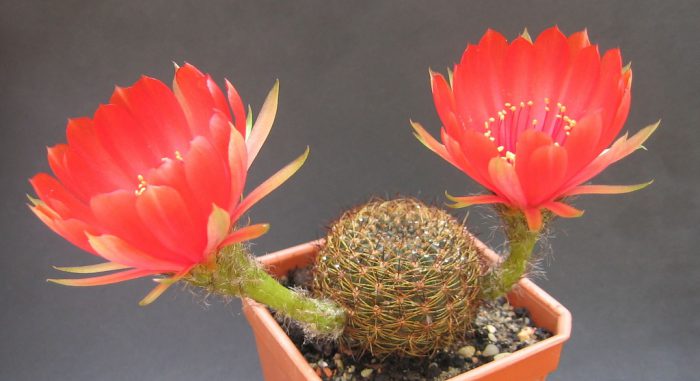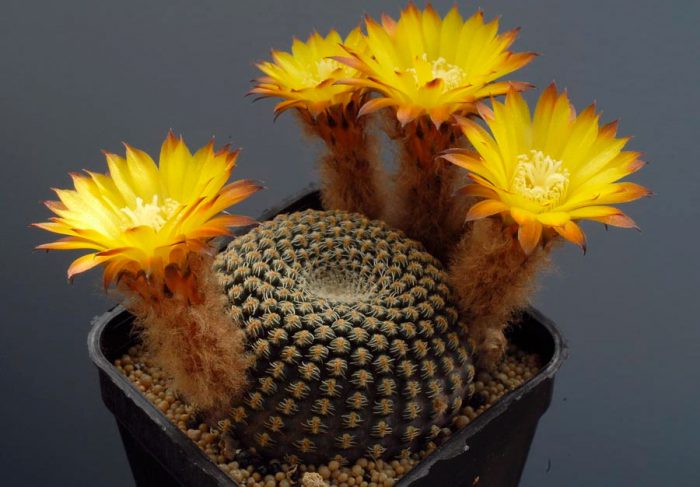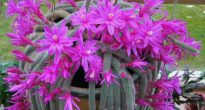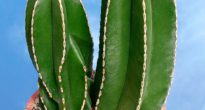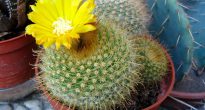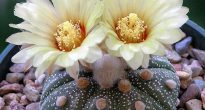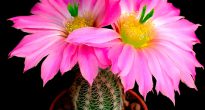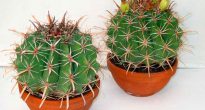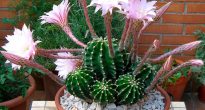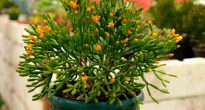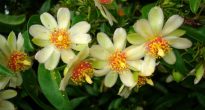Genus lobivia (Lobivia) brings together 70 to 100 different types of cactus (according to various sources). At the moment he is included in the genus echinopsis (Echinopsis), but there are directories where the outdated classification is located. Under natural conditions, such plants can be found only in certain places, namely, in the highlands of Peru, Bolivia and Argentina. An interesting fact is that these plants were named after Bolivia, but their name is an anagram.
This plant looks like a "classic" cactus. A young plant has a symmetrical ball-shaped stem. Over time, it becomes cylindrical. The stalk of the cactus is not branching, however, over time, a lot of basal children are formed in it. Due to this feature, 1 cactus growing in natural conditions can form rather large cushion-like colonies. The ribs of these plants are of varying degrees of roundness or sharp. On small costal tubercles are areoles, from which bunches of rather rigid spines emerge. Separated single flowers are funnel-shaped and form in areoles on the upper part of the stem (lateral). As a rule, pedicels have a rather dense pubescence, but sometimes they are covered with thorns. The corolla tube is quite long (about 30 centimeters), and the opening is 15 centimeters in diameter. Flowers can be of very different colors, even multi-colored is found. About 25 flowers can open at the same time on an adult cactus, and each of them can last from 1 to 3 days.
Lobivia care at home
Practically, like all cacti, this plant is undemanding to care for and not capricious. However, in order for it to grow and develop normally at home, you should know and follow several rules related to care.
Illumination
This plant is very demanding on lighting. So, for successful flowering, a cactus needs bright sunlight in large quantities. It is recommended to place it near a south-facing window. In the event that it is not possible to place lobivia on the southern window, then it will need to be provided with supplementary lighting using phytolamps. So, experts in the cultivation of cacti advise the use of high-intensity lamps intended for greenhouses with a power of 100 watts. In this case, for lighting 0.1 m2 1 light bulb is enough.
Temperature regime
You feel normal at a temperature typical for central Russia. However, you should know that this plant needs sharp changes in day and night temperatures. In this regard, it is recommended to move it to the street, where it should be from mid-spring to mid-autumn. A place should be chosen well protected from precipitation.
In winter, the cactus has a dormant period. At this time, the recommended temperature for him is 8-10 degrees. The flowering intensity depends on the cold wintering.
How to water
During intensive growth, lobivia is watered very carefully. So, it will be necessary to moisten the earth abundantly only after the soil in the pot dries well. Overflow is unacceptable, because it can provoke stem rot and death of the plant. In the middle of the summer period, you should not water the plants for 4 weeks, and then you need to resume normal watering again. However, in the fall, each time it is watered less and less. In November, they stop watering the cactus again. The "dry" period lasts until spring, watering is resumed only after the formation of flower buds. It is necessary to strictly follow this watering regime, otherwise the plant will drop the buds.
Humidity
Feels good with low humidity.
Earth mix
Suitable soil should be neutral, loose, well-permeable to air and water. For planting, you can purchase a special earthen mixture for cacti, only you need to add a little fine gravel and coarse sand to it.
For planting, you should choose a wide and low enough pot, since the roots of the plant are superficial, and also because it gives a lot of basal processes.
Transplant features
It is recommended to replant the plant in spring and only after the overgrown cactus becomes cramped in the old pot.
Fertilizer
It is necessary to feed during intensive growth (March-September) 2 times a month. To do this, use special fertilizers for cacti. During the dormant period (October-February), it is prohibited to apply fertilizers to the soil.
Reproduction methods
Can be propagated by seeds and root processes.
For vegetative propagation, the lateral shoot must be carefully separated from the parent plant. Then it must be left in the air to dry. After 24 hours, it is planted in a soil mixture, to which more sand should be added. When the cactus is rooted, it is transplanted into a permanent pot.
For propagation by seeds, you must follow the instructions in the instructions on the package.
Pests and diseases
Often they settle on the plant aphids, scabbards, spider mites or mealybugs... If pests are found, treat the plant with a special insecticide.
Root rot may appear due to overflow.
Main types
Lobivia arachnacantha
It is a compact dwarf cactus that grows up to 4 centimeters in height. The stem has smooth, blunt ribs, of which there are about 14 pieces. They are densely covered with spines tightly pressed to the surface, which grow from tiny tubercles. The flowers have a diameter that is 2 or 3 times larger than that of the stem. They have a rich yellow color. There are also varieties in which red flowers have spectacular stamens with snow-white anthers.
Lobivia gold (Lobivia aurea)
Plants of this species are quite tall. So, an adult specimen can grow up to 20-50 centimeters in height, while the stem has a diameter equal to 12 centimeters. Pronounced ribs have fairly sharp edges. Each of the areoles has 4 central rather thick spines (2–6 centimeters long), as well as 8 to 10 radial spines (about 1 centimeter long). Large flowers have a diameter of 10 centimeters.They are colored lemon-yellow with a rich yellow spot inside the calyx. Thanks to breeders, varieties with pink, white and red flowers have appeared.
Lobivia Tigeliana (Lobivia tiegeliana)
It has a height of 10 centimeters and a diameter of 4 to 6 centimeters. It has wide and low ribs. On each of the areoles there are needle-shaped spines (from 10 to 20 pieces). At the same time, there are from 1 to 3 central spines and they reach 10 millimeters in length, and all the rest are thin radial spines with a length of 6 to 10 millimeters. Lilac-red little flowers are 2.5 centimeters long and 4 centimeters in diameter.
Lobivia famatimensis
The difference between this cactus is the presence of a large number of clearly distinguishable sharp edges. So, often there are about 24 of them on the stem. The short, thin spines are very difficult to see, as they are pressed tightly to the surface. Flowers of a rich yellow color reach 3 centimeters in length, and their diameter is 6 centimeters.
Lobivia jajoiana
This cactus is also quite compact. A spherical stem in diameter reaches from 8 to 10 centimeters. It has a lot of compressed ribs, on which there are clearly visible tubercles of the areola, with dark thin spines located on them (in the amount of 15 pieces). The longest central spines are 7 millimeters long. This species has become widespread due to the unusually beautiful and rather large, goblet-shaped flowers. They can be colored deep red or yellow and at the same time they have a wide dark purple throat, and also have spectacular stamens with snow-white anthers.

